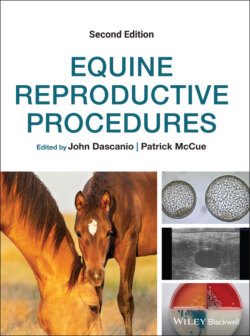Читать книгу Equine Reproductive Procedures - Группа авторов - Страница 43
Interpretation
ОглавлениеA cytology brush may yield significantly more cells than a swab for interpretation.
Distortion of cells may occur when a swab is rolled across a slide or during the collection of cells. This is more common if the swab is smeared instead of rolled across the slide.
Note any discharge present on the sterile sleeve when the gloved arm is pulled from the vagina. There should not be any purulent or hemorrhagic discharge, only the lubricant and clear mucus should be present.
Ensure that the culture device is intact and that no part of the instrument was left within the mare’s reproductive tract. Breakage of the swab/brush is more likely when the device is placed into a dependent uterus (older broodmare) and rotated, causing undue stress on the device tip.
Note any discharge on the tip of the culture device. It is not uncommon to see very mild hemorrhage on the culture device as it rubbed against the endometrium.
Microscopic examination is performed at 400× (10× eye piece and 40× objective) magnification for uterine endometrial cells (individual cells and rafts of cells), white blood cells, debris, red blood cells, bacteria, yeast, fungal organisms, and spermatozoa. Evaluation at 1,000× (10× eye piece and 100× oil immersion objective) may be required to confirm the presence of bacterial and fungal pathogens initially detected at 400×.
Evaluate slide quality (i.e., the presence of normal uterine epithelial cells as well as the presence and relative number of inflammatory cells (neutrophils, macrophages, lymphocytes, etc.) and any bacteria/fungi). If a low number of cells are present on the slide, the cytology should be repeated to obtain a diagnostic quality slide.
The greater the ratio of neutrophils: uterine epithelial cells, the greater the degree of inflammation or endometritis.
Neutrophils are primarily associated with acute inflammation, whereas macrophages, lymphocytes, and plasma cells are more common with chronic inflammation.
The presence of inflammatory cells does not necessarily indicate infectious endometritis. Inflammatory cells may be present in cases of pneumo‐uterus, reflux of urine into the uterus, or after normal procedures such as breeding, uterine lavage, or infusion. The case history and results of other diagnostic procedures should be considered in mares with a positive uterine cytology to differentiate infectious from non‐infectious endometritis.
The absence of inflammatory cells in a sample with an adequate number of normal endometrial cells generally indicates the absence of active inflammation. However, some bacteria, such as Escherichia coli, do not stimulate a large inflammatory response, whereas other bacteria, such as Streptococcus equi subspecies zooepidemicus are associated with a significant inflammatory response.
